Korean Cooking Tips for Perfect Dishes Every Time

Welcome to the vibrant world of Korean cooking! Have you ever enjoyed spicy kimchi or bibimbap and wondered how to make it? I’ve been there too. Starting this food journey has been very rewarding for me!
If you’re new to Korean cooking, or want to get better, knowing the basics helps a lot. Korean food is about sharing meals and happiness. I love this aspect very much.
You can find what you need for Korean dishes in local U.S. markets. Let’s learn about the key ingredients and tricks that bring out true Korean flavors. Ready to excite your taste buds with a taste of Korea?
Key Takeaways
- Learn Korean cooking basics to enhance your culinary skills.
- Discover a step-by-step Korean cooking guide tailored for beginners.
- Understand the importance of communal meals in Korean culture.
- Explore accessible ingredients available at U.S. markets.
- Begin your journey with staple dishes like bibimbap and kimchi.
Understanding Essential Korean Ingredients
Hey there, fellow cooking enthusiasts! Let’s dive into Authentic Korean cooking together. We’ll explore vibrant, flavorful Korean spices and ingredients that make Korean dishes come alive. Imagine blending these unique elements to create an unforgettable meal!
Key Spices and Condiments
The core of Traditional Korean cooking is its unique spices and condiments. Ever tried gochugaru? It’s a type of Korean red pepper flake that offers a smoky sweetness to dishes. Then, there’s doenjang, a fermented soybean paste adding umami richness. And we can’t skip gochujang – a savory, spicy fermented essential in our pantry!
Popular Vegetables in Korean Cuisine
Let’s talk about essential veggies in Authentic Korean cooking. Kimchi is a must-try – it’s fermented and seasoned perfectly. Napa cabbage, radishes, and cucumbers are also stars in banchan (side dishes). These veggies not only add nutrition but also vibrant flavors to Korean meals.
Unique Meats for Authentic Dishes
In Traditional Korean cooking, the meat variety is amazing! Coastal areas love their seafood like squid and shrimp. Inland, you’ll find meats like pork and beef. Each region in Korea has its own meat dishes, showing off local flavors. It’s like a flavorful tour of Korea!
To wrap it up, Korean spices and ingredients are the essence of its cuisine. Are you ready to spice up your kitchen with these essentials?
The Importance of Preparation
Getting Korean dishes right starts with good prep. From marinating meats to chopping veggies, every step matters. Here are some ideas to make your Korean cooking better.
Marinating Your Meats
Marinating is crucial in Korean cooking. Mix soy sauce, pear juice, garlic, and sugar to soak your meats. It makes them tender and full of flavor. Your bulgogi and galbi will taste amazing!
This careful marinating makes dishes juicy and full of Korean tastes.
Chopping Techniques for Korean Dishes
Chopping right is key for Korean food. You must know how to cut veggies properly. It makes for better texture and cooking.
Cut green onions thin for garnish or carrots just right for Bibimbap. Using sharp knives or a mandoline helps a lot.
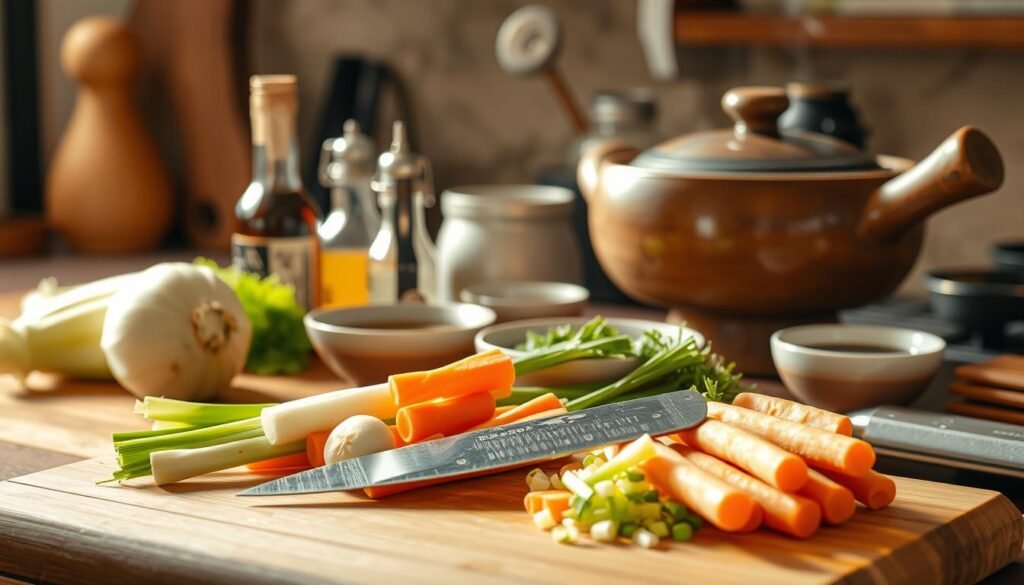
Cooking Techniques Unique to Korean Cuisine
Exploring Korean cooking at home is fun with its unique methods. They make each ingredient shine! Let’s look at some top Korean ways to cook. And some soup tips to boost your cooking skills.
Grilling vs. Stir-Frying
In Korean cooking, grilling is key, especially for BBQ meats like bulgogi and galbi. The grilled meat’s smoky taste and crispness are special. Stir-frying, though, is great for quick veggie sides or dishes like japchae. It makes veggies tender and blends flavors well.
Steaming and Boiling
Steaming and boiling are essential for rice and soups. Ever steamed dumplings or boiled kimchi stew? These methods keep food’s nutrition and taste, ensuring meals are fulfilling and tasty. For Korean soups, slow simmering your broth adds flavor depth!

Building Flavor: The Art of Seasoning
Mastering how to season food is key in Korean cooking. It makes dishes really stand out. When you cook Korean side dishes or a big stew, knowing how to mix sweet, spicy, and savory makes everything better.
Balancing Sweet, Spicy, and Savory
In Korean cooking, mixing sweet, spicy, and savory is really important. This is done with sauces like gochujang (red chili paste), soy sauce, and sesame oil. Add honey or sugar to these, and you’ll get a taste that’s just right. For side dishes, a little sweetness softens the spices, making things perfectly balanced.
Layering Flavors in Soups and Stews
When you make Korean stews, adding flavors one by one is key. Start with a strong stock. Often, this means cooking bones for a long time. Then add veggies, meats, and bold spices slowly.
This way, everything blends well, giving you a rich, comforting taste. Using fresh ingredients makes your soups and stews taste even better. They’re full of flavor without adding stuff you don’t need.
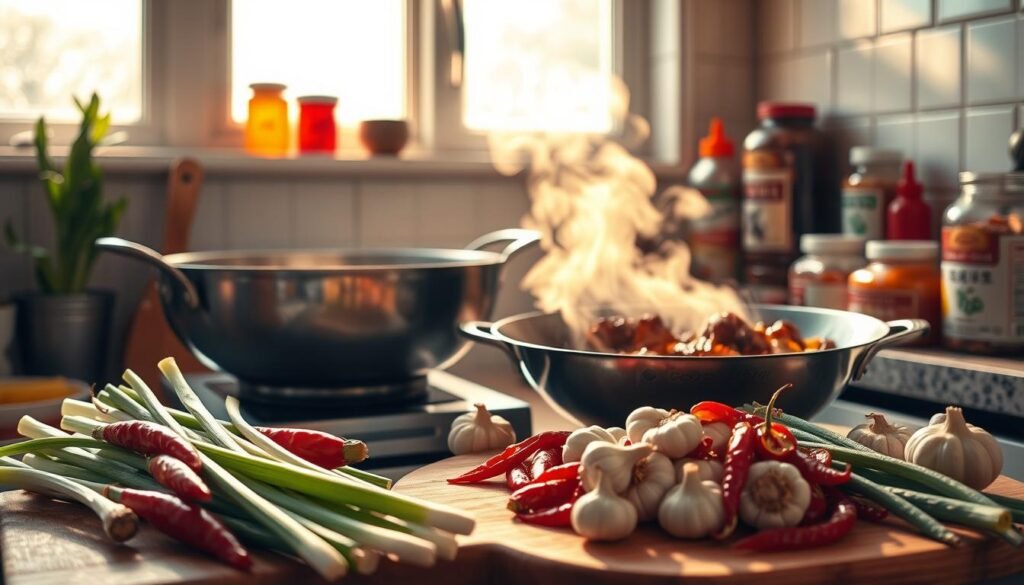
Exploring Popular Korean Dishes
Welcome to Korean cuisine’s colorful world! You may be a pro chef or just a beginner. Let’s explore Korea’s famous dishes. With Korean cooking with kimchi and quick Korean meals, bring Korean flavors to your home.
Bibimbap: A Rice Bowl with Flair
Bibimbap shows off Korean rice cooking in a beautiful way. Picture a bowl with fresh veggies, tasty meat, an egg, and spicy sauce on top. It’s a fully loaded, healthy, and yummy meal!
Kimchi: The Fermented Staple
We can’t talk about Korean food without kimchi. Made from fermented veggies like cabbage, it’s full of good probiotics. Korean cooking with kimchi makes your meals healthier and tastier. Trying it in quick Korean meals? It changes everything!

Bulgogi: Marinated Grilled Beef
Bulgogi shows how Koreans master marinating. Beef gets soaked in soy sauce, sugar, oil, garlic, and pepper. Then it’s grilled. You get soft, tasty meat that the whole world loves. Eat it with rice for a true Korean rice cooking moment.
These dishes let you taste Korea and learn about its cooking culture. So, why wait? Start cooking some quick Korean meals now!
Cooking the Perfect Rice
Cooking Korean rice right can change your meal! It’s not just a side; it’s the meal’s heart. With simple tips, you can make fluffy, tasty rice fast.
Choosing the Right Rice
Finding the right rice is key. For Korean food, short-grain rice is used. It’s sticky and great for tasty dishes. I love Koshihikari rice for its flavor and texture. Wondering which rice to choose? Here’s a guide:
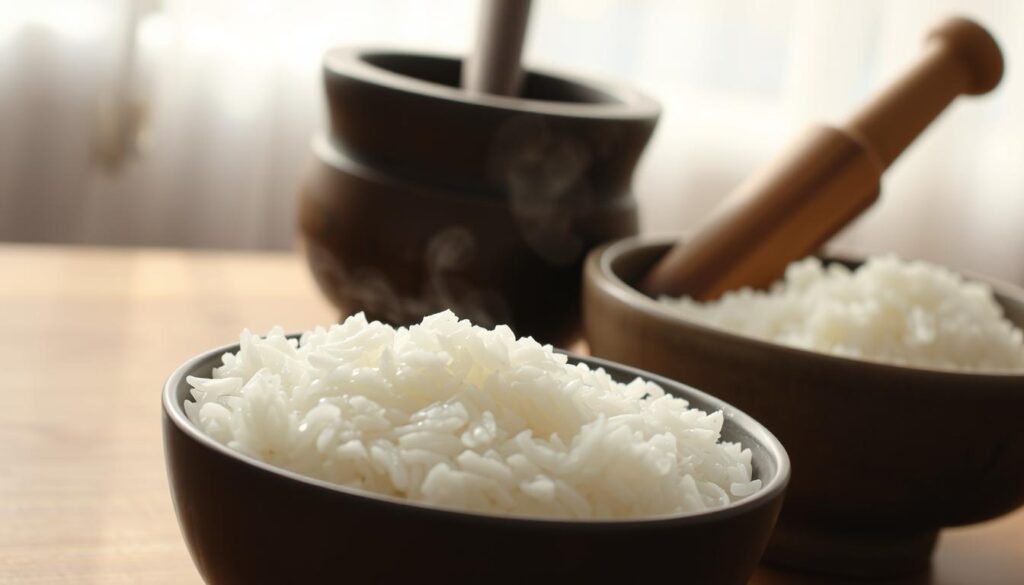
| Type of Rice | Texture | Best For |
|---|---|---|
| Short-Grain Rice | Sticky | Everyday Korean meals |
| Medium-Grain Rice | Semi-Sticky | Versatile dishes |
| Long-Grain Rice | Fluffy | Fried rice, salads |
Cooking Methods for Fluffy Rice
Let’s dive into making fluffy rice. Rinse your rice well, at least three times. This cuts starch, giving a better taste and texture. Then, get the water-to-rice ratio right; 1:1.25 is good for short-grain rice. After cooking, let the rice steam for 10 minutes. These steps are key for perfect Korean rice!
Side Dishes: Banchan Basics
In Traditional Korean cooking, banchan, or side dishes, are thrilling to prepare and serve. These small, flavorful dishes are crucial at every meal in Korea. They bring diversity and enhance meals with different flavors and textures.
Common Types of Banchan
In Cooking Korean side dishes, some foods are often seen. Kimchi is always on the table, made from fermented veggies and spices. There’s also namul, veggies that are seasoned and possibly sautéed or marinated. Jeon, or Korean pancakes, are made with things like veggies and seafood. We also have myulchi bokkeum, or stir-fried anchovies, for a crispy taste.
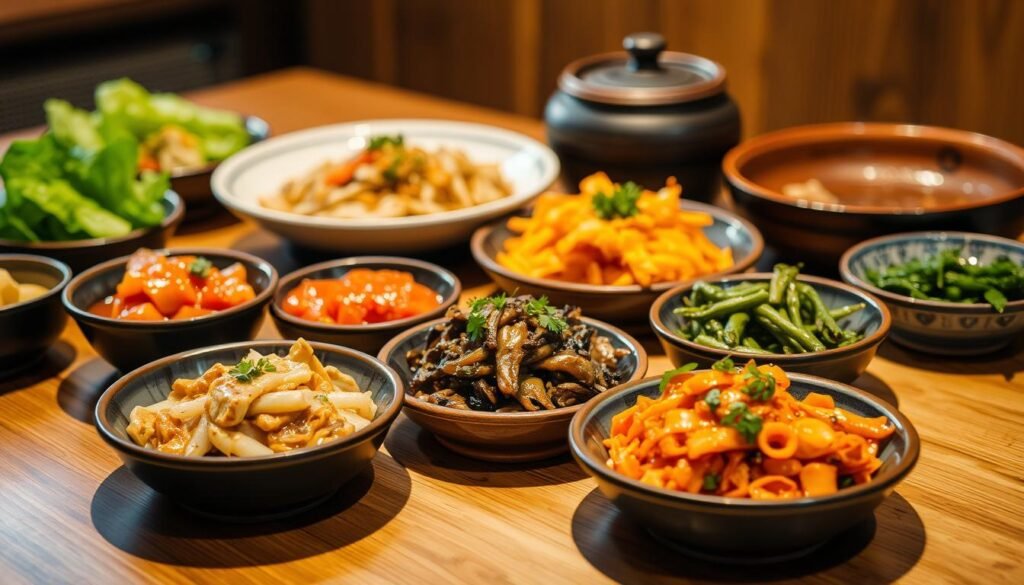
Serving Suggestions for Banchan
The way you serve banchan matters a lot. Korean side dishes go in small dishes, spread out for everyone to share. This makes the meal more fun and together. Each dish offers different tastes, from sweet to spicy. The small sizes mean you can try many types, making each meal special!
| Banchan Type | Flavor Profile | Preparation |
|---|---|---|
| Kimchi | Spicy, tangy | Fermented vegetables with spices |
| Namul | Salty, savory | Seasoned and sautéed vegetables |
| Jeon | Rich, hearty | Pancakes made with various ingredients |
| Myulchi Bokkeum | Sweet, savory | Stir-fried anchovies |
Having a mix of banchans ensures everyone finds a favorite dish. So, let’s get into Cooking Korean side dishes! We’ll fill our tables with many tasty Korean dishes. This shows the true spirit of Traditional Korean cooking!
The Role of Community in Korean Cooking
In Korea, food is more than just what we eat. It brings people together and celebrates our connections. Community Korean cooking is vital in everyday life, from busy markets to cozy home kitchens.
Family Gatherings and Meals
Family events often focus on homemade dishes that show the heart of Korean cooking for family meals. Imagine a big table with steaming stews, tasty meats, and lots of side dishes. It’s a feast that unites us, making memories that last. It’s special that these recipes have been part of family gatherings for so long.
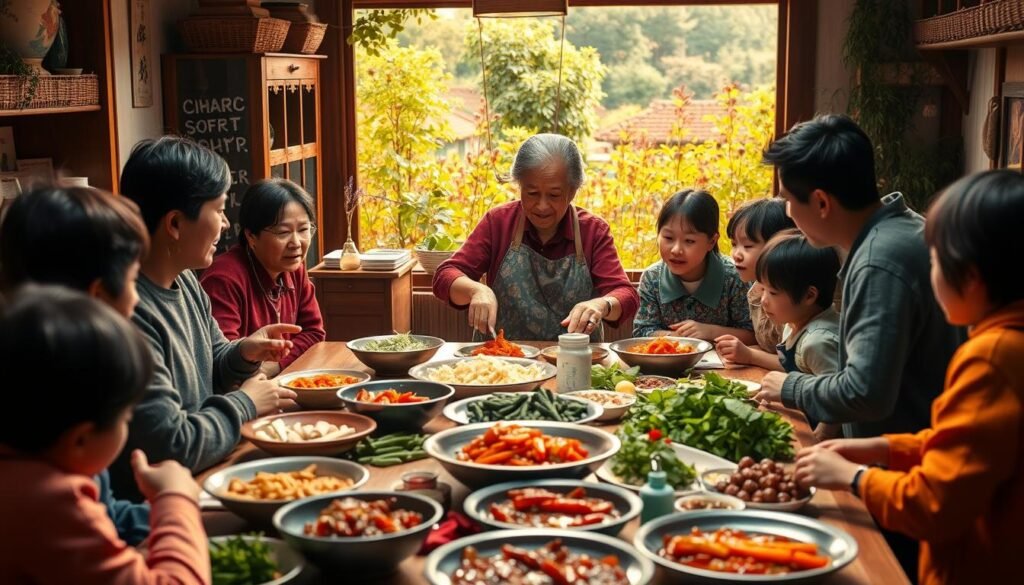
Influences of Korean Culture on Cooking
Cultural influences in Korean food are deep and focus on tradition and togetherness. Cooking secrets are handed down, letting each family add their special taste. From the spices we use to the veggies we choose, each has its own tale. Learning these dishes connects us to our history and the joy of now. How cool is it that food brings us together in such a meaningful way?
| Aspect | Traditional Influence | Modern Adaptation |
|---|---|---|
| Cooking Methods | Hand-pounded spices, clay pot cooking | Blenders, induction cooktops |
| Main Ingredients | Locally sourced vegetables, traditional meats | Imported produce, plant-based alternatives |
| Social Setting | Large family gatherings | Intimate dinners, virtual meetups |
Adapting Korean Recipes for Dietary Needs
Korean food can be changed to fit different diets without losing its taste. We can make vegetarian, vegan, and gluten-free versions of our favorite Korean meals. This way, we keep the delicious, bold flavors of Korean cuisine.
Vegetarian and Vegan Options
Want to enjoy healthy Korean food without meat? There are great ways to do that. Using tofu is a smart choice for those avoiding meat. Tofu can be used to make yummy dishes like soondubu jjigae (soft tofu stew) and kimchi jjigae using vegetable broth. Throw in veggies like mushrooms, zucchini, and spinach to make it tastier.
You can also try dishes centered around vegetables. Dishes like yachaejeon (vegetable pancakes) are a hit. Or, go for Korean-style noodles with mixed vegetables, known as japchae.
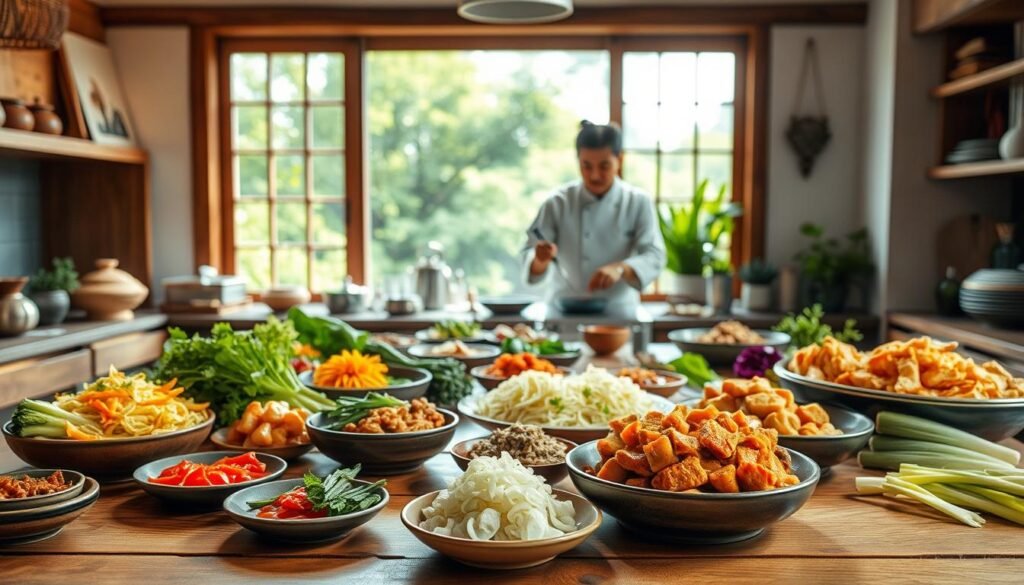
Gluten-Free Modifications
Going gluten-free? You can still enjoy Korean food! Use tamari or gluten-free soy sauce instead of regular soy sauce. This switch makes it easy to adapt sauces and marinades. Also, for side dishes, make simple, tasty ones like seasoned tofu and kimchi (be sure it’s gluten-free). Adding steamed veggies with sesame oil is another great choice. With these changes, everyone can dig into healthy Korean meals without gluten.
| Dietary Preference | Substitutions | Example Dishes |
|---|---|---|
| Vegetarian/Vegan | Tofu, Mushrooms, Veggie Broth | Tofu Stew, Vegetable Pancakes, Japchae |
| Gluten-Free | Tamari, Gluten-Free Soy Sauce | Seasoned Tofu, Kimchi, Steamed Veggies |
Tips for Cooking Korean BBQ at Home
Cooking Korean BBQ at home is like bringing Korea’s tastes to your kitchen. It’s easier than you think to get amazing results. This is even if it’s your first time trying Korean food.
Essential Equipment for Korean BBQ
To cook Korean BBQ right, having the right tools is key. You’ll need a solid grill or a stovetop grill pan for the real deal at home. A table-top grill is great for sharing meals. Remember to have tongs and cutting tools ready for your ingredients!
Best Marinades and Seasonings
The secret to Korean BBQ’s taste is in the marinades and seasonings. It’s all about a mix of sweet, salty, and savory. Use soy sauce, garlic, sugar, and sesame oil for classic flavors. Add gochujang or pear juice for some tangy sweetness in your dishes!
So, are you set to make Korean BBQ at home? Get your grill out, mix those marinades, and enjoy the process!
Exploring Regional Differences in Korean Cuisine
Looking into regional Korean cooking opens up a world of authentic Korean flavors. Korea’s varied landscapes and cultures have led to many unique dishes across provinces. We’ll see how local specialties show the special character of traditional Korean dishes by region.
The Flavors of Jeolla Province
Jeolla Province is known for its colorful and varied food scene. It uses lots of chili peppers and seafood, leading to bold tastes. Jeolla’s Bibimbap, for example, includes many fresh veggies and gochujang for a special flavor.
The area’s coastal location means lots of fresh seafood in its meals. This is key in many local recipes.
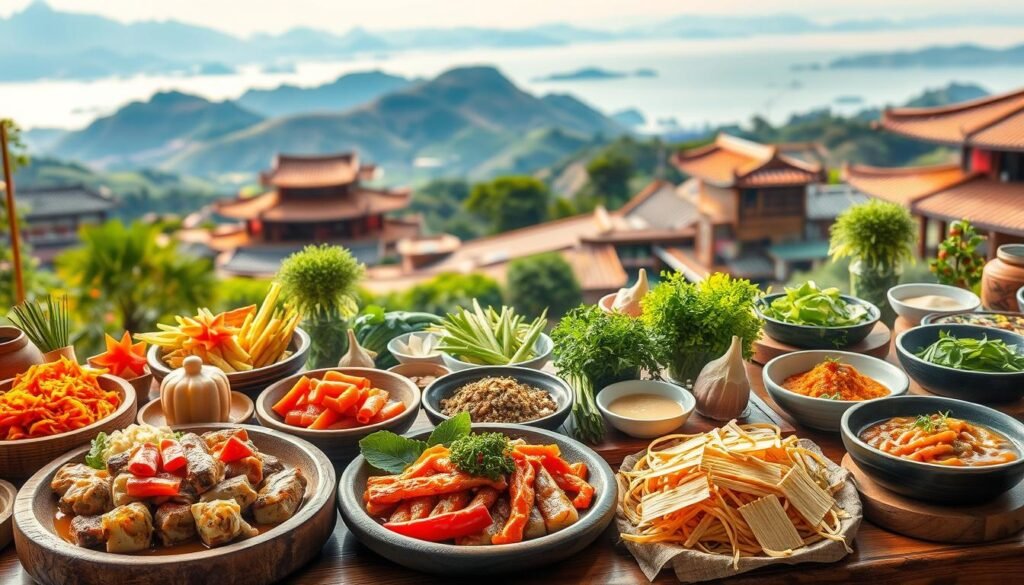
Rustic Dishes from Gyeongsang Province
Gyeongsang Province brings hearty, comforting dishes. Meals here focus on nourishing broths and stews. Specialties like Galbi-jjim (braised short ribs) and Doenjang-jjigae (soybean paste stew) show off strong, wholesome flavors.
These flavors and simple ingredients highlight the region’s farming background. They stress the importance of home-cooked meals that unite families.
Resources for Further Korean Cooking Exploration
If you love Korean cooking like me, there’s lots to explore. Many resources can help you learn more about it. There are cookbooks by expert chefs and lively Korean markets. You’ll find many ways to learn about delicious Korean flavors.
Cookbooks and Online Resources
“Maangchi’s Real Korean Cooking” and “Koreatown: A Cookbook” are great books. They’re not just recipes. They show cultural insights and cooking tips. Online, Maangchi’s YouTube channel has helpful video tutorials. It’s great for learning visually.
Local Korean Markets in the U.S.
True ingredients are key for Korean cooking. Local Korean markets have all you need, from produce to spices. In big cities, you’ll find H Mart with its wide range. Not in a big city? No problem! Many markets ship items online. So, you can still cook with gochujang or kimchi.
Exploring Korean cooking resources boosts your skills and love for Korean food. Enjoy your cooking journey!